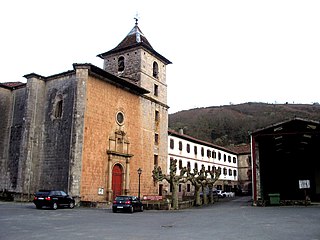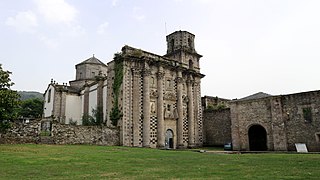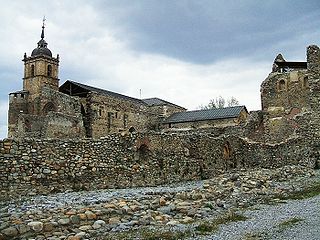
Cintruénigo is a Spanish town and municipality located in the province and autonomous community of Navarre, northern Spain. Situated in the Merindad de Tudela in the Ribera de Navarra, in the comarca of Tudela in the lower reaches of the Alhama river and 92 km from the capital of the autonomous community, Pamplona. Its population in 2020 was of 8026 according to the Instituto Nacional de Estadistica.

Urdazubi/Urdax is a village and municipality located in the autonomous community of Navarre, in the north of Spain.

The Monastery of Santa Maria de Santes Creus, is a former Cistercian monastery in the municipality of Aiguamúrcia, Catalonia, Spain. The abbey was erected in the 12th century, in today's municipality of Aiguamurcia, in the village of Santes Creus, in the province of Tarragona (Catalonia). However, it was in the thirteenth century when Peter III of Aragon expressed his desire to be buried in the monastery and a royal crypt was built for himself and his son, King James II that many of the local nobility established the custom to choose this place for burial. This led to the monastery to increase in splendor and greatness thanks to the numerous donations received.

St. Bernard de Clairvaux Church is a medieval Spanish monastery cloister which was built in the town of Sacramenia in Segovia, Spain, in the 12th century but dismantled in the 20th century and shipped to New York City in the United States. It was eventually reassembled at 16711 West Dixie Highway, North Miami Beach, Florida, where it is now an Episcopal church and tourist attraction called Ancient Spanish Monastery.

The Abbey of Fontenay is a former Cistercian abbey located in the commune of Marmagne, near Montbard, in the département of Côte-d'Or in France. It was founded by Saint Bernard of Clairvaux in 1118, and built in the Romanesque style. It is one of the oldest and most complete Cistercian abbeys in Europe, and became a UNESCO World Heritage Site in 1981. Of the original complex comprising church, dormitory, cloister, chapter house, caldarium, refectory, dovecote and forge, all remain intact except the refectory and are well maintained. The Abbey of Fontenay, along with other Cistercian abbeys, forms a connecting link between Romanesque and Gothic architecture.

The Alcobaça Monastery is a Catholic monastic complex located in the town of Alcobaça, in central Portugal, some 120 km north of Lisbon. The monastery was established in 1153 by the first Portuguese king, Afonso Henriques, and would develop a close association with the Portuguese monarchy throughout its seven-century-long history.

Monfero Abbey is a former Cistercian monastery dedicated to Mary, Mother of Jesus, in the province of A Coruña in Galicia, Spain. It is located in Monfero in Ferrolterra in the comarca of Eume, about 22 km to the north-east of Betanzos.

Monasterio de Piedra is a monastery, hotel and park complex in the Iberian System mountain ranges, near Nuévalos, province of Zaragoza, Aragon, Spain. The monastery was founded in 1194 by Alfonso II of Aragon, with thirteen Cistercian monks from Poblet Monastery, in an old castle next to the Piedra River, and was dedicated to St. Mary the White. On February 16, 1983, the entire complex was declared a national monument.

Alhama de Aragón is a spa town located in the province of Zaragoza, Aragon, Spain, situated on the river Jalón, a tributary of the Ebro. According to the 2004 census (INE), the municipality has a population of 1,150 inhabitants.

Raymond of Fitero was a monk, abbot, and founder of the Order of Calatrava.

The Monastery of Fitero is a Cistercian monastery located at Fitero, Navarre, Spain, on the banks of the Alhama river.

The Monastery of Saint Mary of Carracedo or the Monasterio de Santa María de Carracedo is an inactive abbey and palace complex, now in semi-restored state near the town of Carracedelo, province of León, Castile and León, Spain. Founded in the tenth century by the Benedictine order, it lies near the Way of Santiago in Northern Spain.

The Comunidad de Calatayud is one of the comarcas of Aragon, Spain. It is one of twelve comarcas (counties) within the province of Zaragoza in Aragón. The administrative headquarters are in the city of Calatayud. Local wine achieved Denominación de Origen status in 1990 and it is the second largest wine-producing area in Aragón after Cariñena (DO). Fruit and wheat are major agricultural products, there is also light industry and tourism. The area is noted for balnearios at Alhama de Aragón, Jaraba and Paracuellos, also for its mudéjar architecture.

Vallbona Abbey, otherwise the Monastery of Santa Maria de Vallbona, is a Cistercian nunnery in Vallbona de les Monges, in the comarca of Urgell, Catalonia, Spain. Founded in the early 12th century, and built between then and the 14th century, it is one of the most important monastic sites in Catalonia. Its church represents an example of transition between Romanesque and Gothic architecture. The abbey was declared a national monument on 3 June 1931.

Royal Monastery of Santa María de Sigena is a convent in Villanueva de Sigena, region of Aragon, Spain. Built between 1183 and 1208, the Romanesque church was founded by Queen Sancha of Castile, wife of Alfonso II of Aragon.

Santa María de Óvila is a former Cistercian monastery built in Spain beginning in 1181 on the Tagus River near Trillo, Guadalajara, about 90 miles (140 km) northeast of Madrid. During prosperous times over the next four centuries, construction projects expanded and improved the small monastery. Its fortunes declined significantly in the 18th century, and in 1835 it was confiscated by the Spanish government and sold to private owners who used its buildings to shelter farm animals.
Monasteries in Spain have a rich artistic and cultural tradition, and serve as testament to Spain's religious history and political-military history, from the Visigothic Period to the Middle Ages. The monasteries played an important role in the recruitment conducted by Christian aristocracy during and after the progress of the Reconquista, with the consequent decline in the Muslim south of the peninsula.

The Monastery of Santa María de Huerta is a Cistercian monastery located in Santa María de Huerta, a town of the Spanish Province of Soria, within the autonomous community of Castile and León. The first stone of the building was laid by Alfonso VII of León and Castile in 1179.

The Casbas Monastery, also known as the Monastery of Santa Maria de la Gloria, is in Casbas de Huesca, a municipality in the province of Huesca, Aragon, Spain. A Bien de Interés Cultural, it was established in 1173 by Countess Oria de Pallars with the support of her husband Arnau Mir, Count of Pallars Jussà, between 1124 and 1174, and the Bishop of Huesca, Esteve de Sant Martí. Bishop Esteve had previously been the abbot of the Cistercian Monastery of Poblet from 1160 until 1165. The first abbess was Isabel, who ruled over the 30 noblewomen who entered the community until 1182. The abbess of Casbas had civil and criminal jurisdiction over her lands beginning in 1178. The Benedictine community of women formally came under the auspices of the Cistercian order in 1196, recognized as such by Pope Celestine III.

The Romanesque style of architecture was introduced in Portugal between the end of the 11th and the beginning of the 12th century. In general, Portuguese cathedrals have a heavy, fortress-like appearance, with crenellations and few decorative elements apart from portals and windows. Portuguese Romanesque cathedrals were later extensively modified, among others the Old Cathedral of Coimbra, although it only had some minor changes.






















